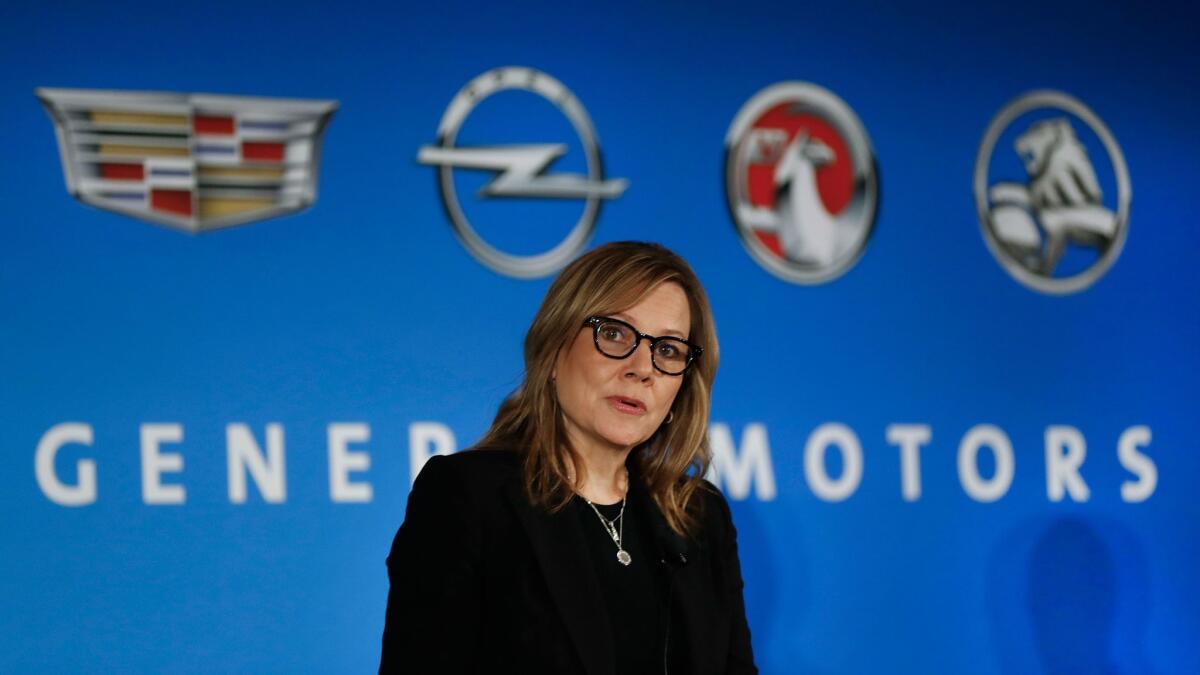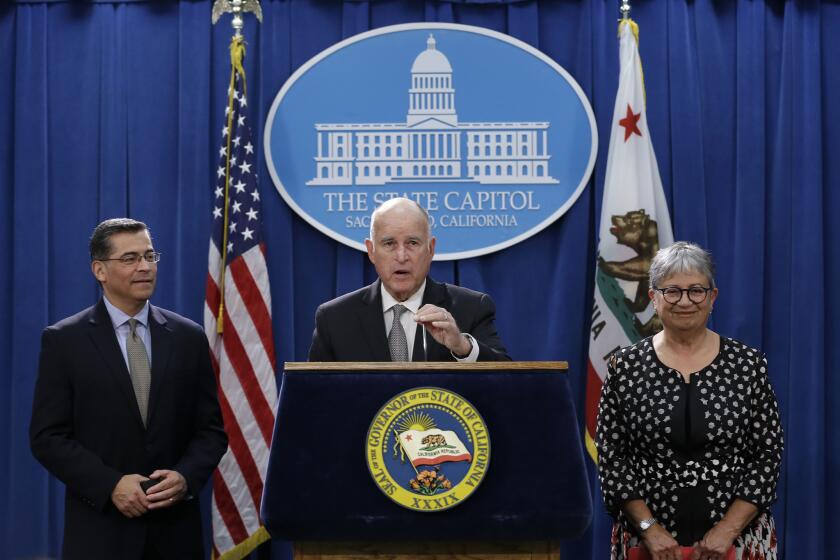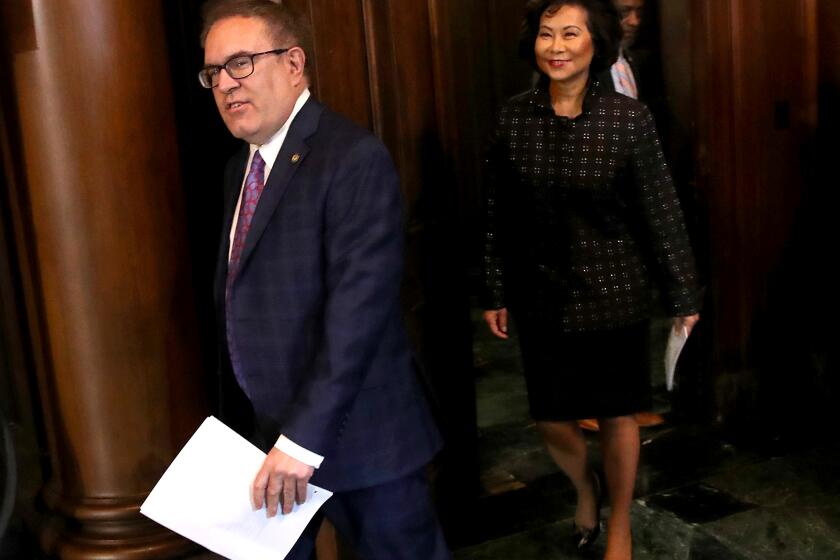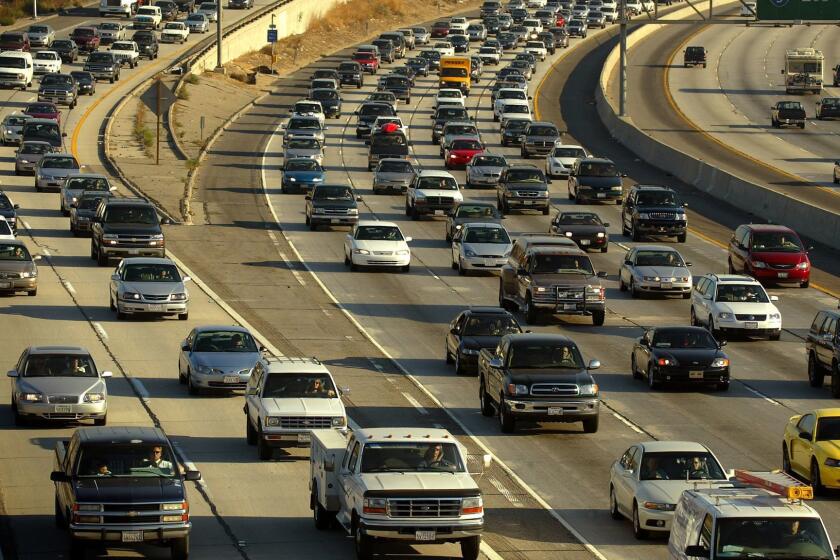Column: GM backs off in its fight over California air standards, but hold your applause

- Share via
General Motors is collecting kudos this week for abandoning its fight with California over auto emissions rules. Before joining in the chorus of applause, you should read the fine print.
The fine print says that GM isn’t actually abandoning its quest for a rollback of auto emissions standards imposed during the Obama administration. These were eviscerated by President Trump in a move that split the auto industry.
Trump’s related move to revoke the federal waiver allowing California to set its own emissions rules produced a pushback in federal court from California, 22 other states, and the cities of Los Angeles, New York and Washington, D.C.
They’re putting down the weapon aimed at California’s waiver. But they’re still pushing for lower emission standards.
— Dan Becker, Center for Biological Diversity
GM was on the Trump side in that lawsuit, which is to say: the wrong side.
Now the big automaker is starting the process of making amends. But it’s only going partway.
The process began Monday with GM’s announcement that it is “immediately withdrawing” from the lawsuit over the California waiver and “inviting other automakers to join us.”
The announcement came in a letter from Mary Barra, GM’s CEO, to the heads of 11 environmental groups that have supported California in the lawsuit. As is often the case with corporate PR, however, what the letter doesn’t say is more important than what it does say.
Barra doesn’t say that GM is bailing on its quest for reduced auto emissions standards, or that it is withdrawing from support for the second lawsuit in the matter, which involves a challenge to Trump’s rollback of emissions rules.
California’s emissions deal with five key automakers takes aim at Trump environmental rollbacks
Nor does her letter say that GM will join Ford, Honda, Volkswagen, BMW of North America, Audi and Volvo in reaching a deal with California to comply with the state’s emissions standards.
“They’re putting down the weapon aimed at California’s waiver,” says Dan Becker, a transportation expert at the Center for Biological Diversity, one of the organizations that received Barra’s letter. “But they’re still pushing for lower emission standards.”
Gov. Newsom, whose call in September to ban the sale of new gasoline-powered cars and light trucks in California by 2035 aimed to jump-start the building of EV-friendly infrastructure, also sounds a bit dubious about GM’s stance.
“GM’s acknowledgment of the reality that the future is zero emissions is further confirmation that it is time to move toward clean cars,” Newsom said after the GM letter was made public.
Newsom alluded to GM’s failure to join the automakers that cut their deal with California: “I hope that GM will join the ranks of other forward-looking carmakers who stand against President Trump’s attack on clean air through clean cars,” he said. “We urge them to stand with California on developing zero emission vehicles that are right for the health of our state, our economy and our communities.”
Barra’s letter indicates that GM’s change of heart over the California waiver case stems in part from the presidential election result. She refers to President-elect Biden’s commitment to a shift to electric vehicles — an evolutionary step that GM has bought into by moving toward an all-EV product line.
Joe Biden’s election points to historic gains in the fight against climate change.
“We are inspired by the President-elect’s Build Back Better plan which outlines a clear intention to expand vehicle electrification in the United States,” Barra wrote.
That said, GM seems to be trying belatedly to make the best out of a mess of its own creation. By siding with Trump in his effort to roll back emissions and auto mileage rules, the company helped to sow chaos in the auto industry.
Automakers always claimed that they were merely seeking a consistent national rule. But if that were really the case, they would have thrown in their lot with California.
The state’s stringent emissions goals were supported by the Obama White House and adopted by 13 other states. That means they applied in about 36% of the U.S. auto market, making them a de facto national standard.
It was obvious, instead, that the industry’s quest was really for relaxed rules.
Until the election, GM could have convinced itself that in fighting California’s initiative and the Obama standard, it had a big bully protecting its back — Donald Trump, abetted by Trump’s team of environmental Visigoths at the Environmental Protection Agency and Department of Transportation.
With the election over, GM looked around and discovered that its backup army had melted into the hills. So now it’s making nice.
GM needs something concrete from the Biden administration: an enhancement of the federal incentives for electric vehicles. As my colleague Russ Mitchell observes, the federal tax credit of up to $7,500 per electric vehicle phases out for automakers that have sold 200,000 eligible cars.
The subsidy for GM buyers expired entirely at the end of March. That means its Bolt EV, the only plug-in model in its product line right now, has effectively become more expensive.
Sales of its coming EVs, which include all-electric Hummers and Cadillacs coming as early as next year, will also become less competitive in what looks to be an EV market that is finally beginning to show some life.
GM’s partnership with Trump did a lot of damage to the fight against climate change, and will have lasting effects. Moreover, it damaged the company’s credibility with environmental advocates. “I don’t think they’re good faith negotiators we can trust,” Becker told me.
California’s ban on gas-fueled vehicles calls the auto industry’s bluff on zero emissions
Because of Trump’s vandalism, restoring the Obama-era emissions rules will be unnecessarily complicated. Trump’s rollback was finalized by the EPA and Department of Transportation; it’s still facing a challenge in federal court, but unless the court rules that it was implemented improperly, the Biden administration will have to undertake a long and complicated administrative process to undo it.
California’s agreement with the six automakers was an end run around Trump’s rollback of the rules and his attack on the California waiver.
The rules established under the Obama administration called for average vehicular fuel efficiency to rise to 54.5 miles per gallon by 2025, applicable in model year 2017 and beyond.
The state’s agreement requires Ford and the other five signing companies to meet a standard of about 50 miles per gallon by 2026. That’s a modest relaxation of the rules, but still far more aggressive than the Trump administration’s plan, which freezes the auto mileage standard at the 2020 level, only 36.9 mpg.
A GM spokeswoman would say only that the California agreements “could possibly be a blueprint” for a GM deal. But the spokeswoman, Jeannine Ginivan, says the company would want to see “stronger support of electric vehicles” in any agreement.
This might include more subsidies for EV sales and an enhanced credit for all-electric vehicles that would allow GM to reach its emissions requirements emissions standards sooner.
What’s most important is that GM solidify its commitment to the environmental standards that it has tried to undermine. The 2026 goal set by California is only a start. Even tougher standards will be needed after that. GM should be leading the auto industry in supporting them. So far, it’s not there.
More to Read
Inside the business of entertainment
The Wide Shot brings you news, analysis and insights on everything from streaming wars to production — and what it all means for the future.
You may occasionally receive promotional content from the Los Angeles Times.














